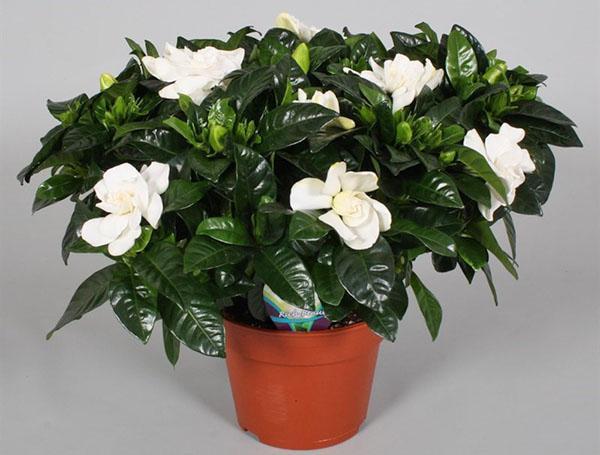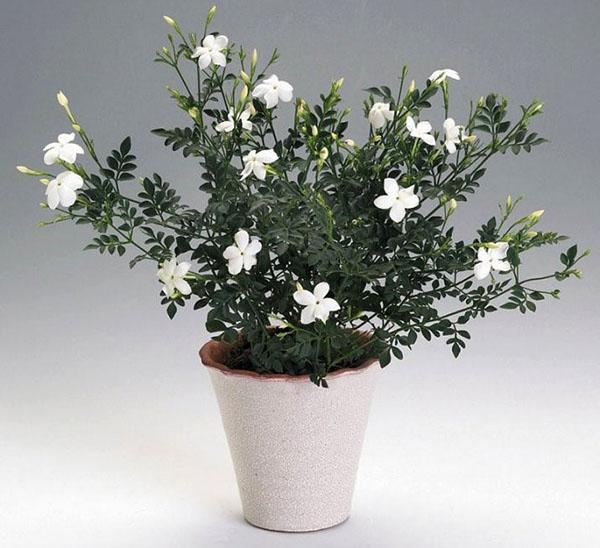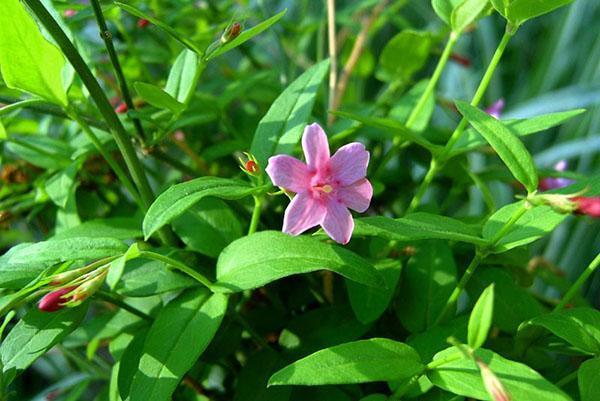Important information about home care for indoor jasmine
 Indoor jasmine is grown in greenhouses and indoors in several varieties. The plant conquers gardeners - lovers with its extraordinary beauty. It differs from other flowers in its constant bright green color of leaves and stems, abundant year-round flowering and aroma. To grow indoor jasmine at home, he will need care. The photo shows a bush plant variety.
Indoor jasmine is grown in greenhouses and indoors in several varieties. The plant conquers gardeners - lovers with its extraordinary beauty. It differs from other flowers in its constant bright green color of leaves and stems, abundant year-round flowering and aroma. To grow indoor jasmine at home, he will need care. The photo shows a bush plant variety.
Most flower varieties do not shed their leaves for the winter, but some species try to get rid of the lush crown and flowers, resting during the cold season.
Types of indoor jasmine
Jasmine indoor flower care is carried out depending on the type of plant. The main ones are presented in the photo:
- jasmine with large flowers;

- jasmine Bissa;

- jasmine with numerous flowers;

- jasmine holoflower;

- jasmine medicinal;

- jasmine sambac.

Jasmine is a delicate flower and it does not tolerate temperature changes, does not tolerate cold. Gardeners who have managed to grow at home and propagate the plant never cease to boast and admire it. Providing proper care, maintaining the temperature regime and being able to deftly plant young shoots, gardeners manage to grow not one, but several plants of extraordinary beauty. So how to care for indoor jasmine?
Complete care for indoor jasmine
 Jasmine indoor flower, it will not grow in the open air, under natural disasters and a constant drop in air temperature. To grow a plant and achieve its flowering, it is necessary to provide it with proper care. In practice, there are cases when gardeners put a lot of effort into active growth and flowering of jasmine, and it dies.
Jasmine indoor flower, it will not grow in the open air, under natural disasters and a constant drop in air temperature. To grow a plant and achieve its flowering, it is necessary to provide it with proper care. In practice, there are cases when gardeners put a lot of effort into active growth and flowering of jasmine, and it dies.
The reasons for the wilting of a plant can be different:
- Sudden changes in air temperature.
- Finding the plant for a long time in direct sunlight.
- Insufficiently moist soil.
- Excess moisture in the soil.
- Low air humidity.
Growing jasmine at home is recommended for experienced professionals who can not only grow a plant, but also achieve its constant flowering.
Lighting criteria for indoor jasmine
 The plant was brought from the tropics, so the flower loves light rooms. When caring for indoor jasmine at home, you should not put the plant on a windowsill under the influence of direct sunlight as in the photo.
The plant was brought from the tropics, so the flower loves light rooms. When caring for indoor jasmine at home, you should not put the plant on a windowsill under the influence of direct sunlight as in the photo.
Under the influence of light, the plant begins to sprout, dissolves a lush deciduous crown and blooms for a long time. Jasmine dries out and withers when exposed to direct sunlight. Jasmine propagation is possible on bedside tables near the window. This is the most illuminated place in the room. Under the influence of artificial light, the plant will not bloom and let new leaves.
Some varieties of jasmine shed most of their foliage from late autumn to mid-spring (during the period of decreased solar activity) and sleep, gaining strength.
Maintaining the temperature for breeding indoor jasmine at home
 When maintaining the temperature in the room from 21 to 26 degrees Celsius, indoor jasmine, with good care at home, will grow and bloom as in the photo.
When maintaining the temperature in the room from 21 to 26 degrees Celsius, indoor jasmine, with good care at home, will grow and bloom as in the photo.
The plant does not tolerate sudden changes in the temperature of the air around it.When readings on a room thermometer are below 15 degrees, jasmine can not only dull in development, but even wither completely. Depending on the type of flower, it tolerates winter in different ways.
 Jasmine - sambac loves to spend the winter in warm temperatures. During the period of rest from flowers, a temperature of 18 degrees Celsius of the surrounding air is enough for him. In order for the plant to begin to bloom profusely and for a long time, gardeners prefer to give the plant a temperature shake and hold it for several hours at a thermometer reading of 10 degrees. In this case, the air humidity must be very high. Having been in such conditions, jasmine will bloom in the near future, and will delight the gardener with its appearance for a long time.
Jasmine - sambac loves to spend the winter in warm temperatures. During the period of rest from flowers, a temperature of 18 degrees Celsius of the surrounding air is enough for him. In order for the plant to begin to bloom profusely and for a long time, gardeners prefer to give the plant a temperature shake and hold it for several hours at a thermometer reading of 10 degrees. In this case, the air humidity must be very high. Having been in such conditions, jasmine will bloom in the near future, and will delight the gardener with its appearance for a long time.
How to properly prune indoor jasmine at home
 Pruning jasmine is held regularly. The plant tolerates crown formation well. Professional gardeners give the plant a new look during the period of abundant flowering. The main pruning of branches and foliage is done in the spring. During this period, the plant (depending on the species) gains strength and begins to grow fruitfully.
Pruning jasmine is held regularly. The plant tolerates crown formation well. Professional gardeners give the plant a new look during the period of abundant flowering. The main pruning of branches and foliage is done in the spring. During this period, the plant (depending on the species) gains strength and begins to grow fruitfully.
Having given the correct shape to jasmine, you can achieve intensity in growth and long-lasting flowering with an unforgettable aroma. The photo shows the plant after spring pruning.
The branches of the plant are cut in half. This method helps the plant to release more young twigs. Special attention is paid to dry branches, leaves and possibly remaining flowers.
How to propagate indoor jasmine
 To propagate a perennial houseplant at home, you must properly cut the cuttings. They are prepared in the warm season, during the jasmine's rest from flowering.
To propagate a perennial houseplant at home, you must properly cut the cuttings. They are prepared in the warm season, during the jasmine's rest from flowering.
How to plant jasmine? Cut off young twigs are planted in small pots filled with a mixture of fertilized soil and sand. The stalk is inserted into a specially prepared soil with a cut cut down to a depth of two centimeters.
 If the air temperature in the room is maintained at least 20 degrees Celsius, the cuttings will begin to take root in one month. After the small pot is completely filled with the root system of the plant, the jasmine must be transplanted into a larger container. With active growth, the plant needs to be transplanted once a year. When the jasmine is three years old, it will need to be cared for like an adult flower. The plant can be pruned, cut by cuttings for further propagation, and replanted every two and a half years.
If the air temperature in the room is maintained at least 20 degrees Celsius, the cuttings will begin to take root in one month. After the small pot is completely filled with the root system of the plant, the jasmine must be transplanted into a larger container. With active growth, the plant needs to be transplanted once a year. When the jasmine is three years old, it will need to be cared for like an adult flower. The plant can be pruned, cut by cuttings for further propagation, and replanted every two and a half years.
Jasmine cuttings do not need to be placed in a glass of water for root development. An individually small pot with fertilized soil is sufficient.